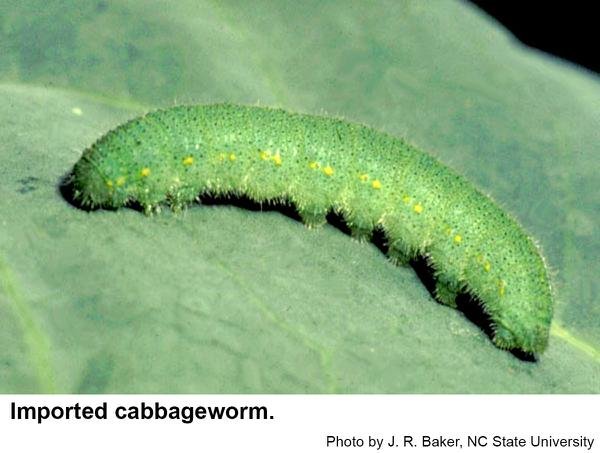Tips for Organic Cabbage Moth Control
Popular Organic Methods for Controlling Cabbage Moths in Your Garden
Imported Cabbageworm
If you’re seeing little holes appear in your kale, cabbage or broccoli plants, inspect the underside of leaves — the holes are often easier to spot than the caterpillars themselves but once you know what to look for, it’ll be easy to identify the cabbageworms.
We want a balanced garden, but not all plants have to be at the mercy of insects. You can use organic methods to protect cabbage plants and other brassica family members like broccoli and kale from cabbage moths. Below are just some proven options:
Handpicking
One of the simplest and most effective ways to control cabbage moths is to remove them by hand. Check your plants regularly for the small, white, butterfly-like moths, and pick them off as soon as you spot them. You can also look for their yellow or orange eggs on the undersides of leaves and remove them. This is my preferred method, and once I pick them off, they get thrown to the chickens.
Row Covers
Great for protecting plants from pests and (some) weather. Plus, they're easy to install!
Row covers
Row covers are an excellent addition to your arsenal of cabbage moth control techniques. These lightweight, breathable fabric covers create a physical barrier between plants and cabbage moths. By covering your crops with row covers, you can effectively prevent the moths from laying their eggs on the plants.
To maximize the effectiveness of row covers, ensure they are securely sealed at the edges. This will help keep cabbage moths and other pests out while allowing sunlight and rain to reach your plants. Row covers are effective against cabbage moths and protect your plants from adverse weather conditions and other garden pests.
Companion planting
Companion planting involves strategically placing certain herbs and flowers near your cabbage plants to deter cabbage moths and attract beneficial insects that prey on them. This method is a natural way to create a balanced ecosystem in your garden.
Here are some companion plants that can help repel cabbage moths and attract helpful allies:
Dill: The aromatic foliage of dill can help deter cabbage moths. Additionally, it attracts hoverflies, which are natural predators of cabbage worms.
Cilantro: Cilantro not only adds flavor to your dishes but also acts as a natural repellent for cabbage moths.
Marigolds: These vibrant flowers release a scent that can deter cabbage moths and other pests. Marigolds also attract beneficial insects like ladybugs and parasitic wasps.
Nasturtiums: The peppery leaves and vibrant flowers of nasturtiums can help protect your cabbage plants by deterring cabbage moths. These plants also attract aphids, which serve as a food source for ladybugs.
Incorporating these companion plants into your garden can create a more pest-resistant environment for your cabbage and brassica family members.
Imported Cabbage Moth
Pieris rapae
Besides the holes in your leaves (I’m looking at you, kale!), another telltale sign of cabbage worms may be the white moths flying around your garden.
Biological Controls
Biological controls, such as Bacillus thuringiensis (Bt) and Neem oil, are popular for managing cabbage moths and their larvae. While these products are considered organic, it's important to mention that they may not align with the preferences of every gardener. Some gardeners prefer to avoid the application of any insecticides, even organic ones, in their gardens.
Bacillus thuringiensis (Bt) is a naturally occurring soil bacterium that produces proteins toxic to certain insect larvae, including cabbage worms. When Bt is applied to your plants, cabbage moth caterpillars that ingest it become lethargic and eventually die. Neem oil, derived from the neem tree, has insecticidal properties and can deter cabbage moths and their larvae.
While these biological controls can be effective, conducting thorough research using peer-reviewed, well-cited sources is essential before deciding to use them. Additionally, consider the overall philosophy of your gardening approach and any local regulations regarding their use.
Frequently Asked Questions about Cabbage Moth Control
-
Caterpillars are attracted to cabbage plants primarily because cabbage is a preferred host plant for certain species of butterflies and moths. Cabbage plants belong to the Brassicaceae family, and many insects, including the cabbage white butterfly (Pieris rapae) and the diamondback moth (Plutella xylostella), lay their eggs on cabbage leaves. The caterpillars that hatch from these eggs feed on the cabbage leaves, making cabbage an ideal food source for their development.
-
Cabbage worms, which are the larval stage of butterflies and moths that feed on cabbage plants, are not harmful to humans. They are herbivorous insects that primarily feed on the leaves of cabbage and related plants. While they can damage cabbage crops and reduce their quality, cabbage worms do not pose any direct health risks to humans. However, it's essential to properly wash and inspect cabbage and other cruciferous vegetables to remove any potential insect residues before consumption.
-
Cabbage worms do not bite humans. These caterpillars are herbivorous insects whose primary purpose is to feed on the leaves of cabbage and related plants. They do not possess biting mouthparts or any means of harming humans. If you come into contact with cabbage worms, there is no need to worry about being bitten by them. However, washing cabbage and other cruciferous vegetables thoroughly is a good practice to remove any potential insect residues before consumption.



